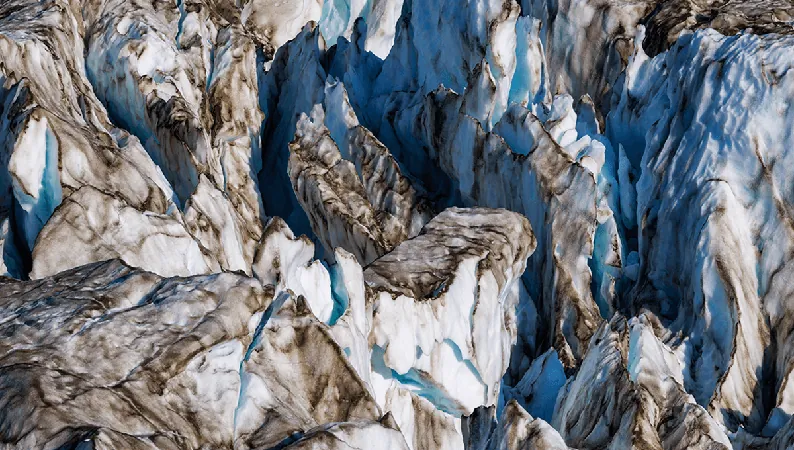
Unearthing the Secrets of 100-Million-Year-Old Dinosaur Eggs: A Jurassic Revelation
2025-06-03
Author: Chun
A Peek into Prehistoric Life
Imagine a vibrant landscape along the ancient Western Interior Seaway, bustling with life 100 million years ago. Seasonal floods shaped low-lying plains while thick forests hugged muddy channels in what we now recognize as central Utah. In this rich environment, dinosaurs roamed alongside early mammals, with ancient crocodile relatives lurking at the water's edge.
Fossils Paint a Dynamic Scene
While fossils from the Mussentuchit Member of the Cedar Mountain Formation have long depicted an active ecosystem, a recent discovery of broken eggshells has added a captivating twist: they tell the story of who was nesting in this ancient neighborhood.
Egg-citing Discoveries from the Rocks
For years, scientists believed only one type of dinosaur egg was hidden in these rocks. However, this perspective shifted dramatically when researchers retrieved over 4,000 eggshell fragments from 20 sites and examined them using advanced microscopes. The findings revealed not one but at least six distinct ootaxa, indicating that various species of dinosaurs shared the same nesting grounds.
Diverse Dinosaur Egg Types
Dr. Josh Hedge, a visiting assistant professor of biology, emphasized the importance of these findings. "The most fascinating aspect is the variety of elongatoolithid eggshells, which are linked to multiple species of oviraptorosaurs. We’re beginning to realize that ecosystems may host more than one kind of each dinosaur species, challenging long-held beliefs." Their analysis suggests the presence of at least two to three different-sized oviraptorosaurs laying eggs in Utah during the same time period.
Unraveling More Than Just Eggs
Key to this discovery are the elongatoolithid shells associated with feathered oviraptorosaurs. These shells bear a striking resemblance to modern bird eggs, hinting at an evolved method of gas exchange that may have enabled dinosaurs to bury their clutches in warm, inviting sand.
Meet the Egg Layers of the Past
Contrary to what their name might suggest, oviraptorosaurs were not merely hulking predators. Most were mid-sized, feathered omnivores equipped with robust beaks and short tails. Recent skeletal discoveries, including early tyrannosaurs like Moros and beaked herbivores like Iani, indicate that a remarkable diversity thrived in this prehistoric ecosystem.
Tracing Ancient Migration Routes
These findings also imply that there was a nuanced traffic flow between Asia and North America via the Beringia land bridge. Similar egg types found in both regions suggest that dinosaur migratory patterns existed long before the so-called 'dinosaur explosion' of the late Cretaceous.
Ecosystem Insights from Eggshells
Nesting sites provide a snapshot of ancient life, revealing clues about clutch spacing, shell thickness, and even parental care. The six distinct ootaxa document a patchwork of nesting strategies, showcasing a diverse habitat that allowed prehistoric creatures to coexist instead of compete.
A Tiny Fragment, A Huge Impact
These humble eggshell shards are challenging our understanding of ancient ecosystems. They highlight that the Late Cretaceous was already a complex web of interdependent species long before the emergence of iconic dinosaurs like Triceratops and Tyrannosaurus.
Hope for Future Discoveries
This study exemplifies how even the smallest fragments of history can provide profound insights into our planet's distant past. With each eggshell, paleontologists unravel the mysteries of an ancient world filled with life, floods, and nurturing parent dinosaurs who raised their young on now-vanished islands. As researchers continue to explore Utah's badlands, the remnants of these 100-million-year-old eggs may yet yield more secrets waiting to be uncovered.




 Brasil (PT)
Brasil (PT)
 Canada (EN)
Canada (EN)
 Chile (ES)
Chile (ES)
 Česko (CS)
Česko (CS)
 대한민국 (KO)
대한민국 (KO)
 España (ES)
España (ES)
 France (FR)
France (FR)
 Hong Kong (EN)
Hong Kong (EN)
 Italia (IT)
Italia (IT)
 日本 (JA)
日本 (JA)
 Magyarország (HU)
Magyarország (HU)
 Norge (NO)
Norge (NO)
 Polska (PL)
Polska (PL)
 Schweiz (DE)
Schweiz (DE)
 Singapore (EN)
Singapore (EN)
 Sverige (SV)
Sverige (SV)
 Suomi (FI)
Suomi (FI)
 Türkiye (TR)
Türkiye (TR)
 الإمارات العربية المتحدة (AR)
الإمارات العربية المتحدة (AR)